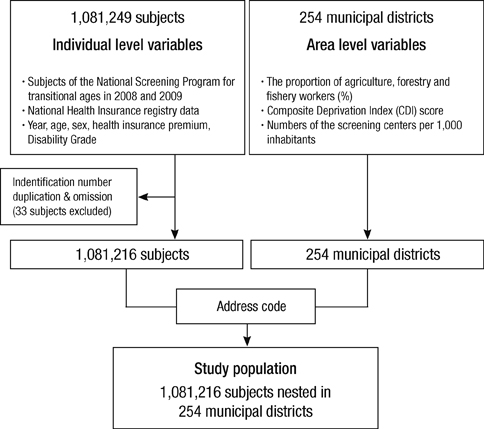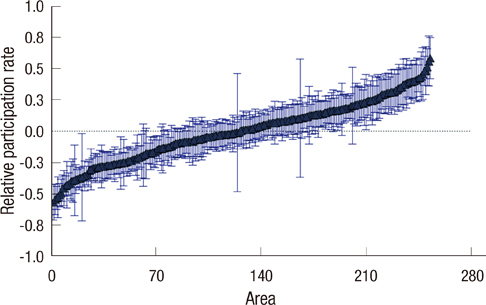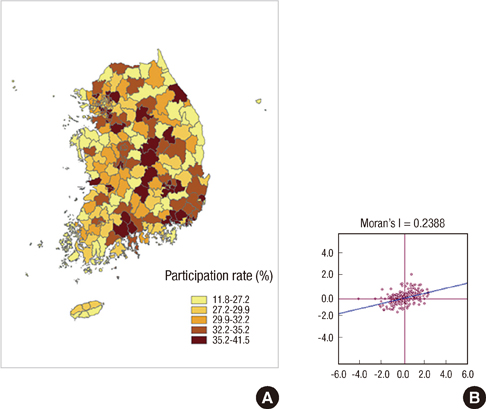J Korean Med Sci.
2013 Mar;28(3):348-356. 10.3346/jkms.2013.28.3.348.
Regional Factors Associated with Participation in the National Health Screening Program: A Multilevel Analysis Using National Data
- Affiliations
-
- 1Department of Family Medicine, Seoul National University Hospital, Seoul, Korea. belong@snu.ac.kr
- 2Department of Social and Preventive Medicine, Inha University School of Medicine, Incheon, Korea.
- 3Institute of Health Policy and Management, Medical Research Center, Seoul National University, Seoul, Korea.
- KMID: 1786930
- DOI: http://doi.org/10.3346/jkms.2013.28.3.348
Abstract
- High participation rates are important for maximizing the effects of a health screening program. Previous studies have suggested that individual or regional characteristics have effects on health behaviors. In this study, we investigated the determinants of participation in the National Screening Program for Transitional Ages by simultaneously analyzing individual and area-level factors by multilevel analysis. A total of 1,081,216 subjects, aged 40 and 66 yr and nested in 254 areas, were included. There was a significant variation in participation rates across the areas even after adjusting for individual and area-level variables. Among the individual-level variables, increasing age, sex, higher income, and mild disability grade were associated with a higher participation rate. In urban areas, the 40-yr-old group had higher participation rates than the 66-yr-old group. Deprived areas had significantly high participation rates for both age groups. The number of screening centers per 1,000 inhabitants had no significant effect on participation in the screening program. In conclusion, regional characteristics are associated with participation rates independent of personal features and regional factors have differential effects with respect to age. A multi-dimensional approach is recommended to promote participation in health screening programs.
Keyword
MeSH Terms
Figure
Reference
-
1. Lee WC, Lee SY. National health screening program of Korea. J Korean Med Assoc. 2010. 53:363–370.2. Park JH, Lee JS, Lee JY, Hong JY, Kim SY, Kim SO, Cho BH, Kim YI, Shin Y, Kim Y. Factors affecting national health insurance mass screening participation in the disabled. J Prev Med Public Health. 2006. 39:511–519.3. Park JH, Lee JS, Lee JY, Gwack J, Park JH, Kim YI, Kim Y. Disparities between persons with and without disabilities in their participation rates in mass screening. Eur J Public Health. 2009. 19:85–90.4. Sung NY, Park EC, Shin HR, Choi KS. Participation rate and related socio-demographic factors in the national cancer screening program. J Prev Med Public Health. 2005. 38:93–100.5. Kwak MS, Park EC, Bang JY, Sung NY, Lee JY, Choi KS. Factors associated with cancer screening participation, Korea. J Prev Med Public Health. 2005. 38:473–481.6. Kim RB, Park KS, Hong DY, Lee CH, Kim JR. Factors associated with cancer screening intention in eligible persons for national cancer screening program. J Prev Med Public Health. 2010. 43:62–72.7. Rutter DR. Attendance and reattendance for breast cancer screening: a prospective 3-year test of the theory of planned behaviour. Br J Health Psychol. 2000. 5:1–13.8. Hahm MI, Choi KS, Kye SY, Kwak MS, Park EC. Factors influencing the intention to have stomach cancer screening. J Prev Med Public Health. 2007. 40:205–212.9. Kye SY, Han EO, Park KH. Predictors of regular gastric cancer screening among Koreans. Asian Pac J Cancer Prev. 2010. 11:1315–1320.10. Robert SA. Community-level socioeconomic status effects on adult health. J Health Soc Behav. 1998. 39:18–37.11. Pruitt SL, Shim MJ, Mullen PD, Vernon SW, Amick BC 3rd. Association of area socioeconomic status and breast, cervical, and colorectal cancer screening: a systematic review. Cancer Epidemiol Biomarkers Prev. 2009. 18:2579–2599.12. Siahpush M, Singh GK. Sociodemographic variations in breast cancer screening behavior among Australian women: results from the 1995 National Health Survey. Prev Med. 2002. 35:174–180.13. Pornet C, Dejardin O, Morlais F, Bouvier V, Launoy G. Socioeconomic determinants for compliance to colorectal cancer screening: a multilevel analysis. J Epidemiol Community Health. 2010. 64:318–324.14. Jang SN, Cho SI, Hwang SS, Jung-Choi K, Im SY, Lee JA, Kim MK. Trend of socioeconomic inequality in participation in cervical cancer screening among Korean women. J Prev Med Public Health. 2007. 40:505–511.15. Lee K, Lim HT, Park SM. Factors associated with use of breast cancer screening services by women aged >or= 40 years in Korea: the third Korea National Health and Nutrition Examination Survey 2005 (KNHANES III). BMC Cancer. 2010. 10:144.16. Roh WN, Lee WC, Kim YB, Park YM, Lee HJ, Meng KH. An analysis on the factors associated with cancer screening in a city. Korean J Epidemiol. 1999. 21:81–92.17. Fukuda Y, Nakamura K, Takano T. Reduced likelihood of cancer screening among women in urban areas and with low socio-economic status: a multilevel analysis in Japan. Public Health. 2005. 119:875–884.18. Chun EJ, Jang SN, Cho SI, Cho Y, Moon OR. Disparities in participation in health examination by socio-economic position among adult Seoul residents. J Prev Med Public Health. 2007. 40:345–350.19. Fukuda Y, Nakamura K, Takano T. Accumulation of health risk behaviours is associated with lower socioeconomic status and women's urban residence: a multilevel analysis in Japan. BMC Public Health. 2005. 5:53.20. Dailey AB, Brumback BA, Livingston MD, Jones BA, Curbow BA, Xu X. Area-level socioeconomic position and repeat mammography screening use: results from the 2005 National Health Interview Survey. Cancer Epidemiol Biomarkers Prev. 2011. 20:2331–2344.21. Kim HS, Shin DW, Lee WC, Kim YT, Cho B. National screening program for transitional ages in Korea: a new screening for strengthening primary prevention and follow-up care. J Korean Med Sci. 2012. 27:S70–S75.22. The National Assembly of the Republic of Korea. Disabled persons welfare act. accessed on 4 November 2012. Available at http://likms.assembly.go.kr.23. Shin H, Lee S, Chu JM. Development of composite deprivation index for Korea: the correlation with standardized mortality ratio. J Prev Med Public Health. 2009. 42:392–402.24. Chu JM, Park JI, Cho MR, Choi SJ, Im JH, Shin HS. Environmental policy for low-income population in urban area. No RE-02S. 2007. Seoul: Korea Environment Institute;106–109.25. Kwon YM, Lim HT, Lee K, Cho BL, Park MS, Son KY, Park SM. Factors associated with use of gastric cancer screening services in Korea. World J Gastroenterol. 2009. 15:3653–3659.26. Maxwell CJ, Bancej CM, Snider J. Predictors of mammography use among Canadian women aged 50-69: findings from the 1996/97 National Population Health Survey. CMAJ. 2001. 164:329–334.27. Schootman M, Jeffe DB, Baker EA, Walker MS. Effect of area poverty rate on cancer screening across US communities. J Epidemiol Community Health. 2006. 60:202–207.28. Meersman SC, Breen N, Pickle LW, Meissner HI, Simon P. Access to mammography screening in a large urban population: a multi-level analysis. Cancer Causes Control. 2009. 20:1469–1482.29. Coughlin SS, Leadbetter S, Richards T, Sabatino SA. Contextual analysis of breast and cervical cancer screening and factors associated with health care access among United States women, 2002. Soc Sci Med. 2008. 66:260–275.30. Kim YB, Ro WO, Lee WC, Park YM, Meng KH. The influence factors on cervical and breast cancers screening behavior of women in a city. J Korean Soc Health Educ Promot. 2000. 17:155–170.
- Full Text Links
- Actions
-
Cited
- CITED
-
- Close
- Share
- Similar articles
-
- Factors Affecting the Participation Rate in the Health Screening Program of Medical Insurance
- A Multi-level Analysis of Factors Affecting Participation in Health Screenings in Korea: A Focus on Household and Regional Factors
- Factors Influencing Participation in National Health Screening Program among Korean Older Adults by Cognitive Function Level
- Regional Variation in National Gastric Cancer Screening Rate in Korea
- Associations of Socioeconomic Status With Depression and Quality of Life in Patients With Hypertension: An Analysis of Data From the 2019 Community Health Survey in Korea






